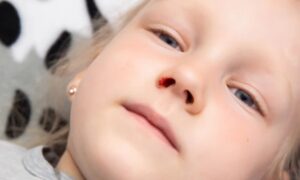Winter is here, and so are common skin issues for kids. For example, 6-year-old Emma recently told her mom that her hands feel itchy and have some white flakes. Meanwhile, 10-year-old Lucas often complains about how tight and dry the skin on his legs feels after a bath. Many parents wonder, “How can I protect my child’s delicate skin from winter dryness?”
Today, let’s talk about simple and practical ways to keep your child’s skin soft and healthy during the cold months.
1. Why Is a Child’s Skin More Prone to Winter Dryness?
Children’s skin is thinner and their skin barrier is not fully developed, making it more vulnerable to external environmental factors. Winter is characterized by low temperatures and low humidity, and indoor heating can make the air even drier. These conditions cause rapid moisture loss, leading to dryness, itching, and even mild dermatitis.
Additionally, activities like playing in the snow, spending time outdoors, or staying in heated rooms for long periods can make skin problems worse.
2. Key Tips to Protect Your Child’s Skin During Winter
(1) Choose Gentle Cleansers
Many parents think that using a lot of foamy soap during baths ensures cleanliness. However, over-cleansing can strip the skin of its natural protective oils.
Suggestions:
- Opt for fragrance-free, soap-free, and gentle cleansers for kids.
- For children with dry skin, use cleansing products containing moisturizing ingredients such as glycerin or oatmeal.
(2) Control Bath Time and Water Temperature
A hot bath might feel cozy in winter, but hot water can worsen skin dryness.
Suggestions:
- Limit bath time to under 10 minutes.
- Keep the water temperature around 37°C (warm, not hot).
- After the bath, gently pat the skin dry with a soft towel instead of rubbing.
(3) Moisturize Regularly
Moisturizing is essential during winter, especially within 3 minutes after a bath when the skin is still slightly damp.
Suggestions:
- Use fragrance-free, hypoallergenic moisturizers designed for sensitive skin.
- Look for ingredients like shea butter, glycerin, or ceramides, which help lock in moisture.
- Apply a thicker cream to particularly dry areas, like elbows and knees, for added protection.
(4) Dress in Comfortable Clothing
While warm clothing is essential in winter, certain fabrics like wool can irritate the skin.
Suggestions:
- Dress your child in soft, breathable cotton as the base layer.
- Avoid direct contact with coarse fabrics like wool.
- Use gloves and scarves when outdoors to shield skin from cold winds.
(5) Maintain Indoor Humidity
While heating keeps homes warm, it also dries out the air, exacerbating skin problems.
Suggestions:
- Use a humidifier to maintain indoor humidity between 40%-60%.
- Clean the humidifier regularly to prevent mold or bacteria buildup.
- Open windows periodically to ensure fresh air circulation.
(6) Support Skin Health Through Nutrition
In addition to external care, a healthy diet can also help maintain skin health.
Suggestions:
- Include foods rich in Omega-3 fatty acids, such as fish, flaxseeds, and walnuts, to strengthen the skin barrier.
- Add foods with Vitamin E and Vitamin A, like carrots, spinach, and nuts.
- Ensure your child drinks plenty of water daily to stay hydrated.
(7) Prevent Scratching and Skin Irritation
If your child experiences itching due to dry skin, scratching can worsen the problem and even lead to infections.
Suggestions:
- Trim their nails to prevent scratching injuries.
- For severe itching, consult a doctor about anti-itch creams or medications.
3. When Should You See a Doctor?
While most dryness issues can be managed with proper care, seek medical advice if:
- The skin cracks, bleeds, or shows signs of infection.
- Dryness is accompanied by severe redness or persistent itching.
- The skin condition does not improve or worsens despite regular care.
4. Summary of Winter Skin Care Tips
Winter skin care for kids doesn’t have to be complicated. By focusing on daily routines, you can effectively protect your child’s skin. Remember: gentle cleansing, timely moisturizing, comfortable clothing, proper indoor humidity, and a balanced diet are the key factors. With a little attention, kids like Emma and Lucas can enjoy healthy, hydrated skin all winter long!
How to Protect Your Child's Skin from Winter Dryness?
Winter is here, and so are common skin issues for kids. For example, 6-year-old Emma recently told her mom that her hands feel itchy and have some white flakes. Meanwhile, 10-year-old Lucas often complains about how tight and dry the skin on his legs feels after a bath. Many parents wonder, “How can I protect my child’s delicate skin from winter dryness?”
Today, let’s talk about simple and practical ways to keep your child’s skin soft and healthy during the cold months.
Children’s skin is thinner and their skin barrier is not fully developed, making it more vulnerable to external environmental factors. Winter is characterized by low temperatures and low humidity, and indoor heating can make the air even drier. These conditions cause rapid moisture loss, leading to dryness, itching, and even mild dermatitis.
Additionally, activities like playing in the snow, spending time outdoors, or staying in heated rooms for long periods can make skin problems worse.
2. Key Tips to Protect Your Child’s Skin During Winter
(1) Choose Gentle Cleansers
Many parents think that using a lot of foamy soap during baths ensures cleanliness. However, over-cleansing can strip the skin of its natural protective oils.
Suggestions:
- Opt for fragrance-free, soap-free, and gentle cleansers for kids.
- For children with dry skin, use cleansing products containing moisturizing ingredients such as glycerin or oatmeal.
(2) Control Bath Time and Water Temperature
A hot bath might feel cozy in winter, but hot water can worsen skin dryness.
Suggestions:
- Limit bath time to under 10 minutes.
- Keep the water temperature around 37°C (warm, not hot).
- After the bath, gently pat the skin dry with a soft towel instead of rubbing.
(3) Moisturize Regularly
Moisturizing is essential during winter, especially within 3 minutes after a bath when the skin is still slightly damp.
Suggestions:
- Use fragrance-free, hypoallergenic moisturizers designed for sensitive skin.
- Look for ingredients like shea butter, glycerin, or ceramides, which help lock in moisture.
- Apply a thicker cream to particularly dry areas, like elbows and knees, for added protection.
(4) Dress in Comfortable Clothing
While warm clothing is essential in winter, certain fabrics like wool can irritate the skin.
Suggestions:
- Dress your child in soft, breathable cotton as the base layer.
- Avoid direct contact with coarse fabrics like wool.
- Use gloves and scarves when outdoors to shield skin from cold winds.
(5) Maintain Indoor Humidity
While heating keeps homes warm, it also dries out the air, exacerbating skin problems.
Suggestions:
- Use a humidifier to maintain indoor humidity between 40%-60%.
- Clean the humidifier regularly to prevent mold or bacteria buildup.
- Open windows periodically to ensure fresh air circulation.
(6) Support Skin Health Through Nutrition
In addition to external care, a healthy diet can also help maintain skin health.
Suggestions:
- Include foods rich in Omega-3 fatty acids, such as fish, flaxseeds, and walnuts, to strengthen the skin barrier.
- Add foods with Vitamin E and Vitamin A, like carrots, spinach, and nuts.
- Ensure your child drinks plenty of water daily to stay hydrated.
(7) Prevent Scratching and Skin Irritation
If your child experiences itching due to dry skin, scratching can worsen the problem and even lead to infections.
Suggestions:
- Trim their nails to prevent scratching injuries.
- For severe itching, consult a doctor about anti-itch creams or medications.
3. When Should You See a Doctor?
While most dryness issues can be managed with proper care, seek medical advice if:
- The skin cracks, bleeds, or shows signs of infection.
- Dryness is accompanied by severe redness or persistent itching.
- The skin condition does not improve or worsens despite regular care.
4. Summary of Winter Skin Care Tips
Winter skin care for kids doesn’t have to be complicated. By focusing on daily routines, you can effectively protect your child’s skin. Remember: gentle cleansing, timely moisturizing, comfortable clothing, proper indoor humidity, and a balanced diet are the key factors. With a little attention, kids like Emma and Lucas can enjoy healthy, hydrated skin all winter long!
References
- American Academy of Dermatology. How to Treat Dry Skin in Children.
- Mayo Clinic. Children's Skin Care Tips for Winter.
- WHO. Tips to Prevent Dry Skin in Winter.
- Harvard Health Publishing. The Role of Omega-3 in Skin Health.








